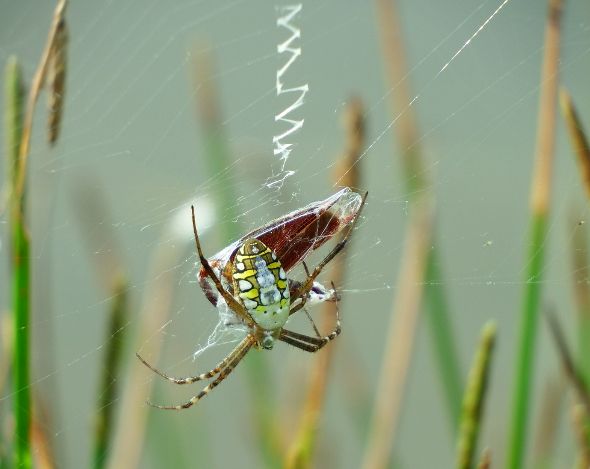“On the morning of 29th November 2014, while skirting a local pond, I noticed that a dragonfly had become ensnared in a spider’s web near the water’s edge. The arachnid predator was a female Yellow-Silver Saint Andrew’s Cross Spider (Argiope catenulata) and was putting the finishing touches of her sticky silk to restrain the male dragonfly prey (below), a Common Parasol (Neurothemis fluctuans).
“When she was satisfied that her silken strands were sufficiently secure, she then proceeded to nibble on the immobilised victim, as well as sucking up all the nutritious juices (below).
“A video clip of this femme fatale having her leisurely brunch may be previewed here:”
Dr. Leong Tzi Ming
Singapore
24th July 2015











4 Responses
I notice the web just above the spider has a zigzag pattern (it looks a little messy though). Is this for reinforcement?
Yes, this zig-zag silk pattern is known as the stabillimentum and it may serve the purpose of reinforcing the web’s stability. It has also been postulated that it may also play a role in attracting insect prey towards the web, with varying success. Such silk ‘decorations’ are often observed in spiders of the genus Argiope.
In my earlier post on this website I mentioned that it could be possible that the prominent zig-zag pattern on the webs of St Andrew’s Cross spiders could be a visual deterrent for birds. It serves no purpose for small birds to crash into the webs. Both parties lose. The spider will have to carry out repairs, while the bird will be temporarily handicapped, and will have to spend time cleaning the sticky mess off its feathers.
Therefore, the theory has been postulated that this family of spiders has devised such highly-reflective and easily visible warning signs on their webs to serve as hazard warnings for small birds.
Indeed, this spider would certainly not welcome a bird crashing into its web, especially when she is having her meal. : )